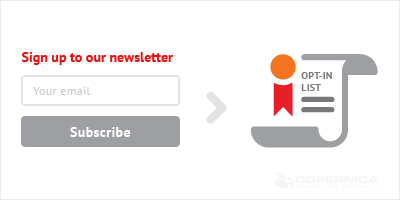Yesterday afternoon, Copernica disabled file downloads upon the discovery of a security risk by one of our users. The reporting user was able to download random files by manually altering URLs. To prevent abuse, all file downloads were disabled completely on the spot.

Six tips for creating and maintaining your emailing list
Email marketing can be a bit tricky sometimes. While it is a very effective way of communicating with your audience and boosting your conversion, there are also many pitfalls to avoid.
Having an up to date and clean database is key if you don’t want to step in a spam trap, send unsolicited emails or make other mistakes that ruin your email reputation.

Six tips that help you create an emailing list with relevant opt ins only, and to make sure it stays that way:
1. What is someone signing up for?
Make it obvious from the start. What kind of information can he expect? How many times will he receive your emailings?
You might scare of some opt ins this way, but that’s no loss to mourn. You’d rather have one opt-in that actually reads your newsletter, than ten that discard it without even opening it.
2. Get the information you need
Relevancy is the single most important factor when sending emailings. Relevant content ensures that recipients open your newsletters and help you boost your conversion.
But to be able to send relevant emails, you need to know what your target audience wants. What kind of products are your recipients interested in? Get the information you need, during the sign up process, or by studying your email results.
3. Use double opt ins
There are various reasons why a single opt in can result in wrong addresses on your mailing list: someone could make a typo, or deliberately sign up an email address other than their own.
Prevent erroneous email addresses from ending up in your database, and always ask people that sign up for your emailings to confirm their subscription, using a double opt in.
How a double opt in works:
- Someone signs up for your emailings, through a web form for example
- You send them an email, asking them to confirm their subscription
4. Don’t buy email addresses
Buying email addresses from a third party might seem like a great way to expand the number of addresses in your database, but will eventually get you into a lot of trouble.
Even if the addresses you acquired were gathered in a legal way, that whole claim goes out the window the second you start emailing these recipients.
In most cases they signed up for someone else’s emailings, not yours. And even if these addresses were acquired in a legal way, most of the times the people on these lists did not opt in for your emails. So not only is sending unsolicited emails illegal in many countries, it’s also a foolproof way to end up on the blacklist of every ISP out there.
5. Keep your list clean
Making sure you only gather relevant and legitimate opt ins is only half the work of keeping a clean emailing list. People change their interests, change jobs or just their email addresses.
That’s why you should always closely monitor your emailings not only for opt outs, but also signs that an email address is no longer valid.
When an email address returns bounces, make sure you stop emailing this address. Sending emails to invalid email addresses is disastrous for your email reputation, especially when one of these addresses gets converted to a spam trap.
6. Make it easy to opt out
Don’t make it too hard for your recipients to unsubscribe from your newsletter. Not only are you required by law to offer an opt-out possibility, there’s little point in sending people emails they won’t ever bother to read. In the worst case, they might even report your emailings as spam.
